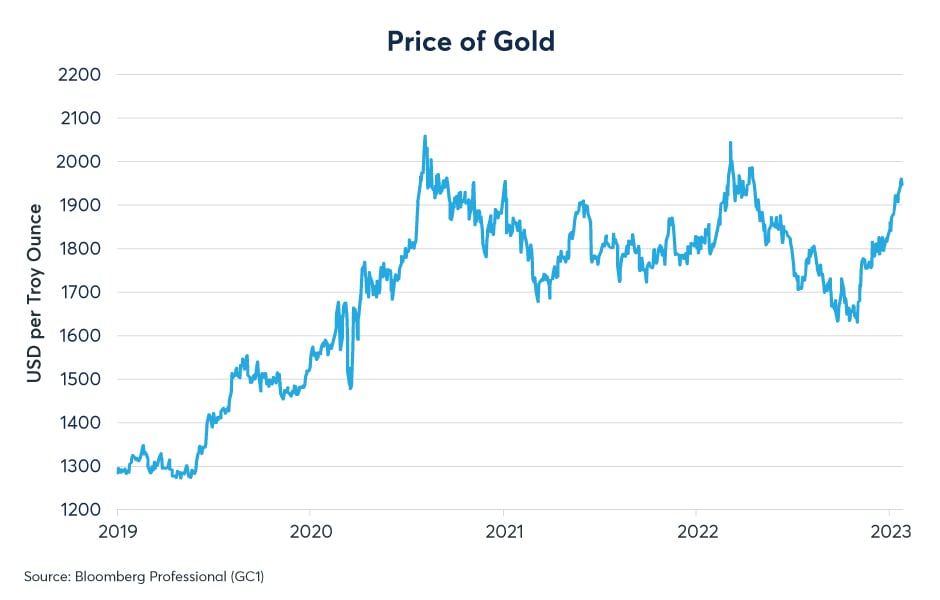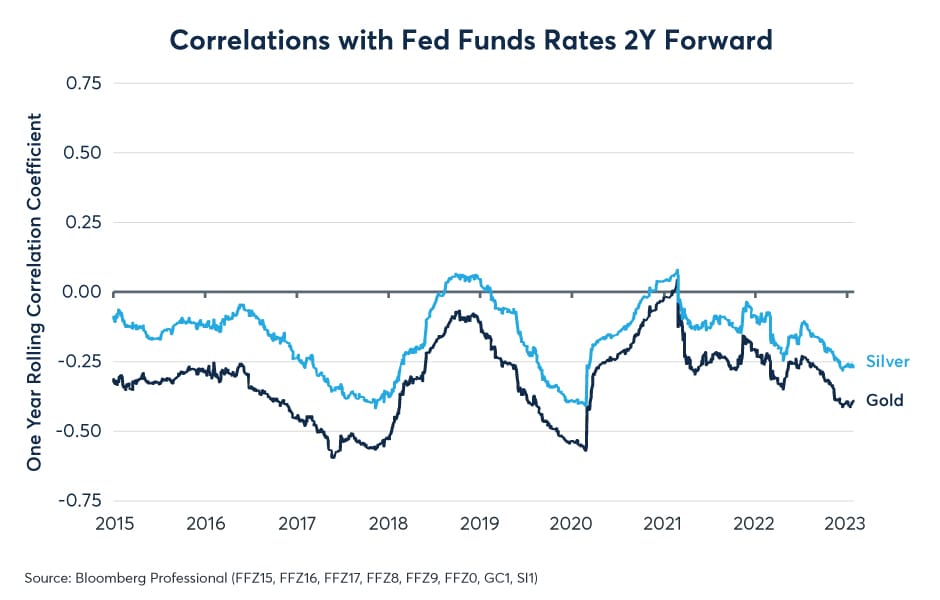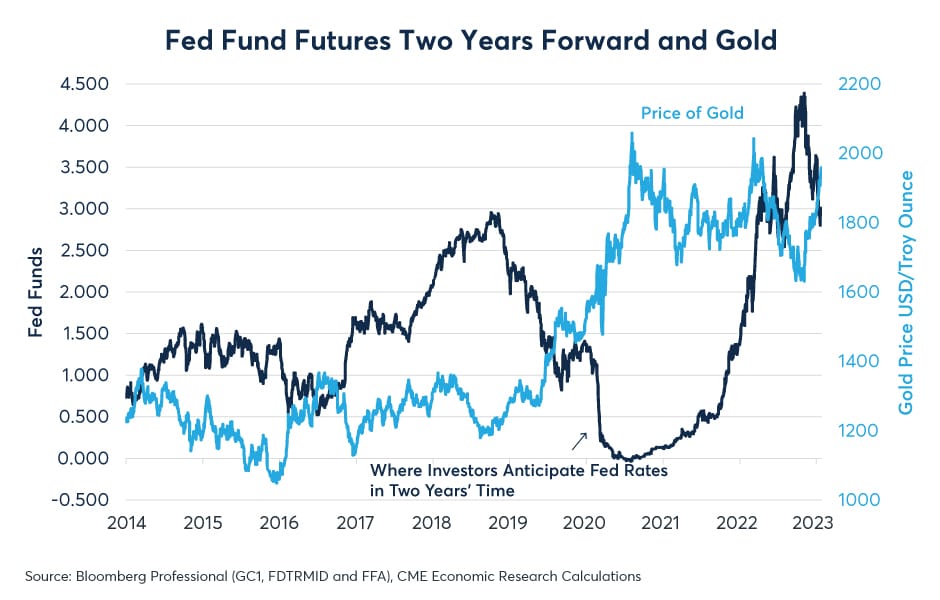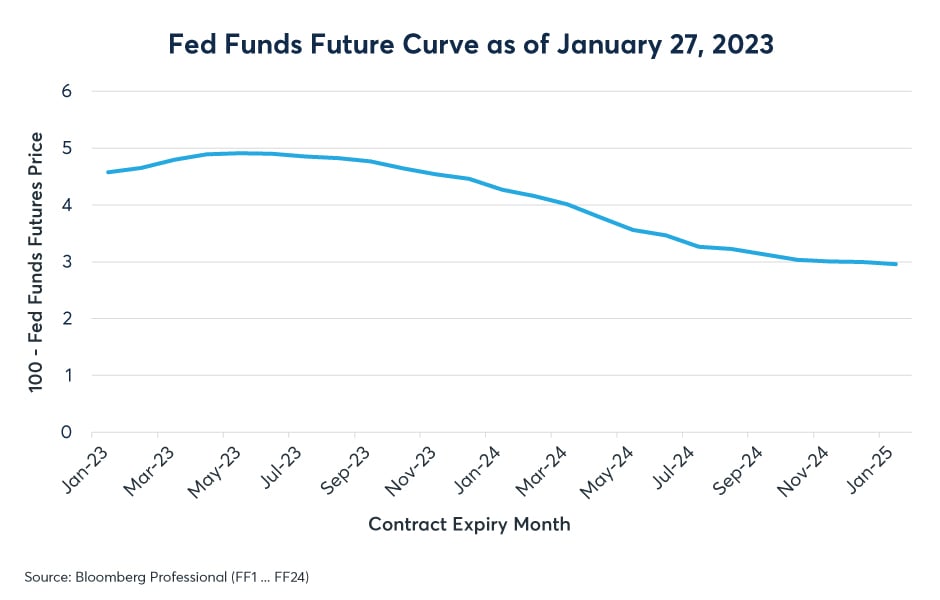The price of gold has risen by over $300 per ounce since hitting its recent low in November 2022. Even so, gold prices are only back to where they were last April. More broadly, gold prices have been range-bound since the summer of 2020. For the past two and a half years, gold has been unable to break past $2,080 to the upside; and even after its recent rally, it’s still about $140 short of that level (Figure 1). So, can the gold rally continue? Could the precious metal break through to new highs in 2023?
Figure 1: Gold has been range-bound since summer 2020

In some ways, gold’s range-bound performance has been surprising. One might have believed that gold, touted as an inflation hedge, would have rallied as inflation surged. Instead, as inflation ramped up from 1.3% in 2020 to above 9% by mid-2022, gold prices went sideways. Even so, saying gold no longer serves as an inflation hedge might be imprudent. Between the spring of 2019 and the summer of 2020, gold prices rallied by nearly 60% as the Federal Reserve (Fed) began easing monetary policy, slowly at first, and then in grand fashion in March 2020 by cutting rates to zero and embarking on what would become a $4.9 trillion quantitative easing program. Rather than failing to be a hedge against inflation, it might be more accurate to say that investors in gold anticipated the high rates of inflation that came about in the two years after its rally ended.

Scan the above QR code for more expert analysis of market events and trends driving opportunities today!
The actual rise of inflation in 2021 and 2022 posed a problem for gold investors. On the one hand, higher inflation means that the dollar and other fiat currencies will be able to buy less of real assets such as precious metals. On the other hand, once central banks came around to the idea that the surge in inflation was not transitory, they began tightening monetary policy at the most rapid pace since 1981.
Higher interest rates are anathema to gold. As a central bank reserve asset, gold is still a sort of de facto global currency, but one that does not pay interest. As the Fed and other central banks began to raise interest rates and reduce the size of their balance sheets, fiat currencies such as the U.S. dollar (USD) appeared relatively more attractive compared to gold despite higher rates of inflation.
Indeed, gold has shown a consistent negative correlation with the day-to-day changes in the expectations for where the Fed’s policy rate might be in two years as priced by the Fed funds rate (Figure 2). Visually, the correlation is apparent. As markets came to expect lower Fed funds rates in 2019 and early 2020, gold prices soared. Then, in late 2020 and 2021, the market concluded that the Fed couldn’t (or wouldn’t) follow Europe and Japan into negative rates and gold stopped rallying. Finally, in 2022, as expectations shifted towards the fastest pace of Fed rate hikes in more than four decades, gold prices fell for the first nine months of the year (Figure 3).
Figure 2: Gold has a consistent negative correlation with expectations for Fed policy rates

Figure 3: Gold prices vary inversely with expectations for Fed rates in two years

So, what changed in Q4? It seems that two related factors contributed to gold’s rally. First, the market concluded that the Fed might show restraint with its rate hikes, and that it might have to start cutting rates in late 2023 and 2024. By January, Fed funds futures priced 200 basis points (bps) of rate cuts beginning in the second half of 2023 (Figure 4). As markets began to price eventual Fed rate cuts, gold rallied.
Figure 4: Fed funds futures now price 200 bps in rate cuts beginning late 2023

The second factor that helped gold to recover was USD. The Fed got out ahead of other major central banks in its policy tightening in mid-2022. This sent the U.S. dollar soaring against the euro, yen, pound, and gold. However, as the Fed signalled a slower pace of rate hikes in Q4, and as other central banks picked up the pace of their tightening, USD began to sell off versus other currencies. A weaker USD tends to boost gold prices, which have shown a consistent, negative correlation with the Bloomberg dollar index over the past decade (Figure 5).
Figure 5: Gold has a negative correlation with day-to-day changes in the U.S. dollar

As such, gold’s ability to rally to its high of $2,080 or past it depends on a number of factors, including:
- Will the Fed actually cut rates by 200 bps or more starting later this year? Or will higher-than-expected inflation, or stronger-than-expected growth prevent policy easing?
- Will the dollar continue to sell-off versus foreign currencies, or will USD rebound?
If inflation proves to be stickier than expected, it might be a double-edged sword for gold. On one side, gold might benefit from a USD that is losing its value against fixed assets more quickly than expected. On the other, higher than expected inflation could prevent the Fed from cutting rates in the manner that the interest rate markets and gold have incorporated into their pricing.
© 2025 Benzinga.com. Benzinga does not provide investment advice. All rights reserved.
Trade confidently with insights and alerts from analyst ratings, free reports and breaking news that affects the stocks you care about.